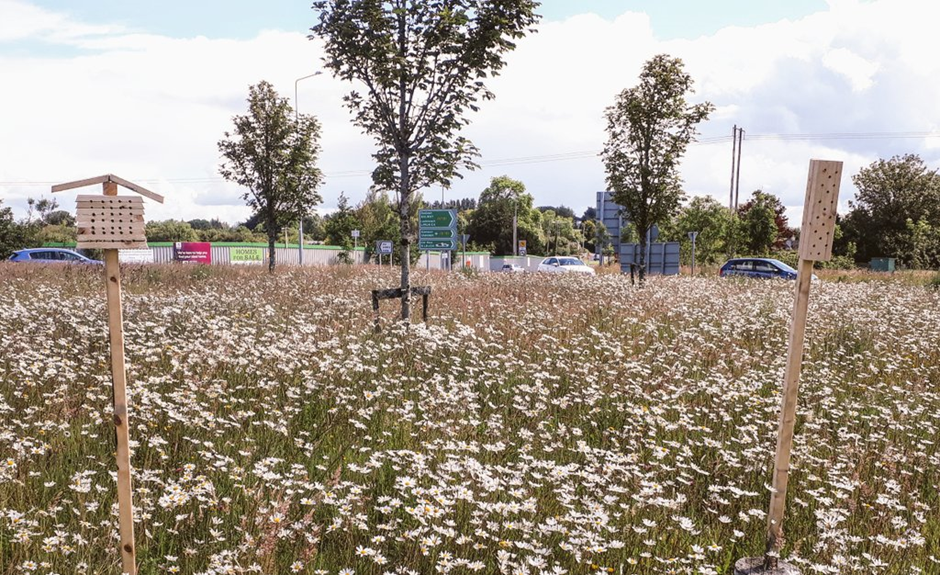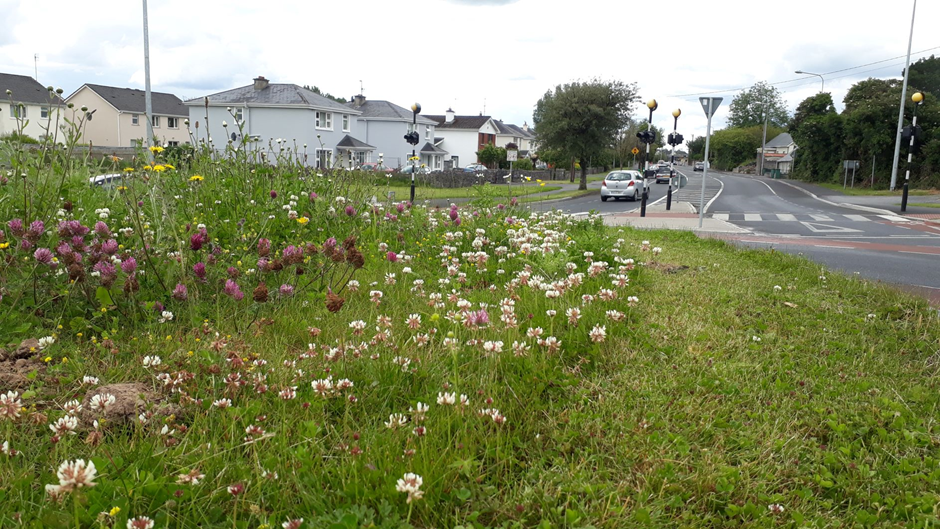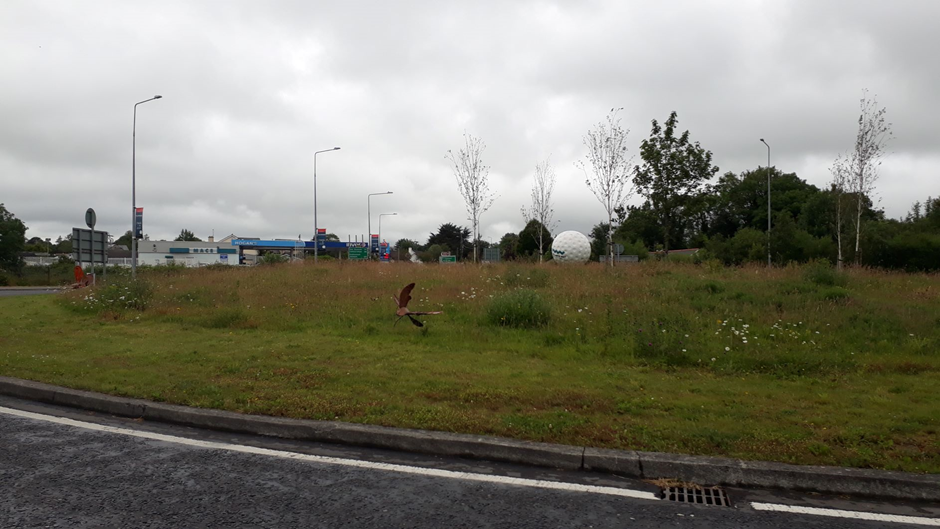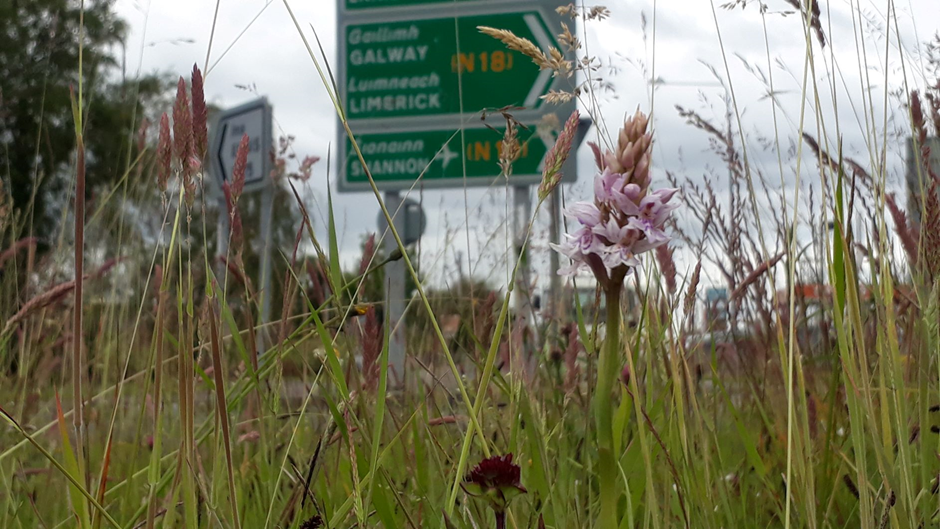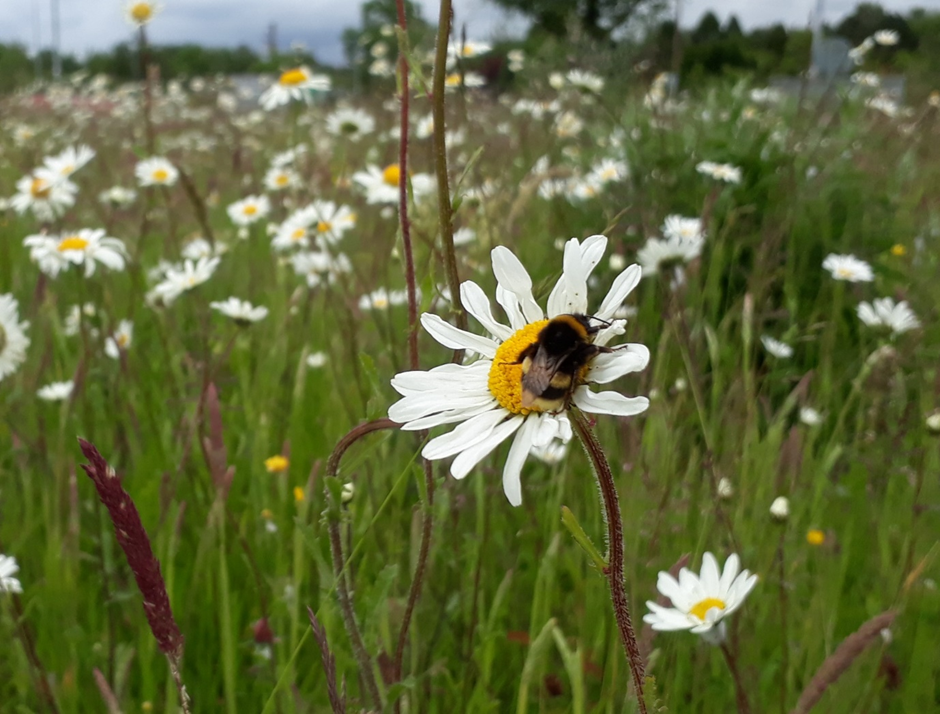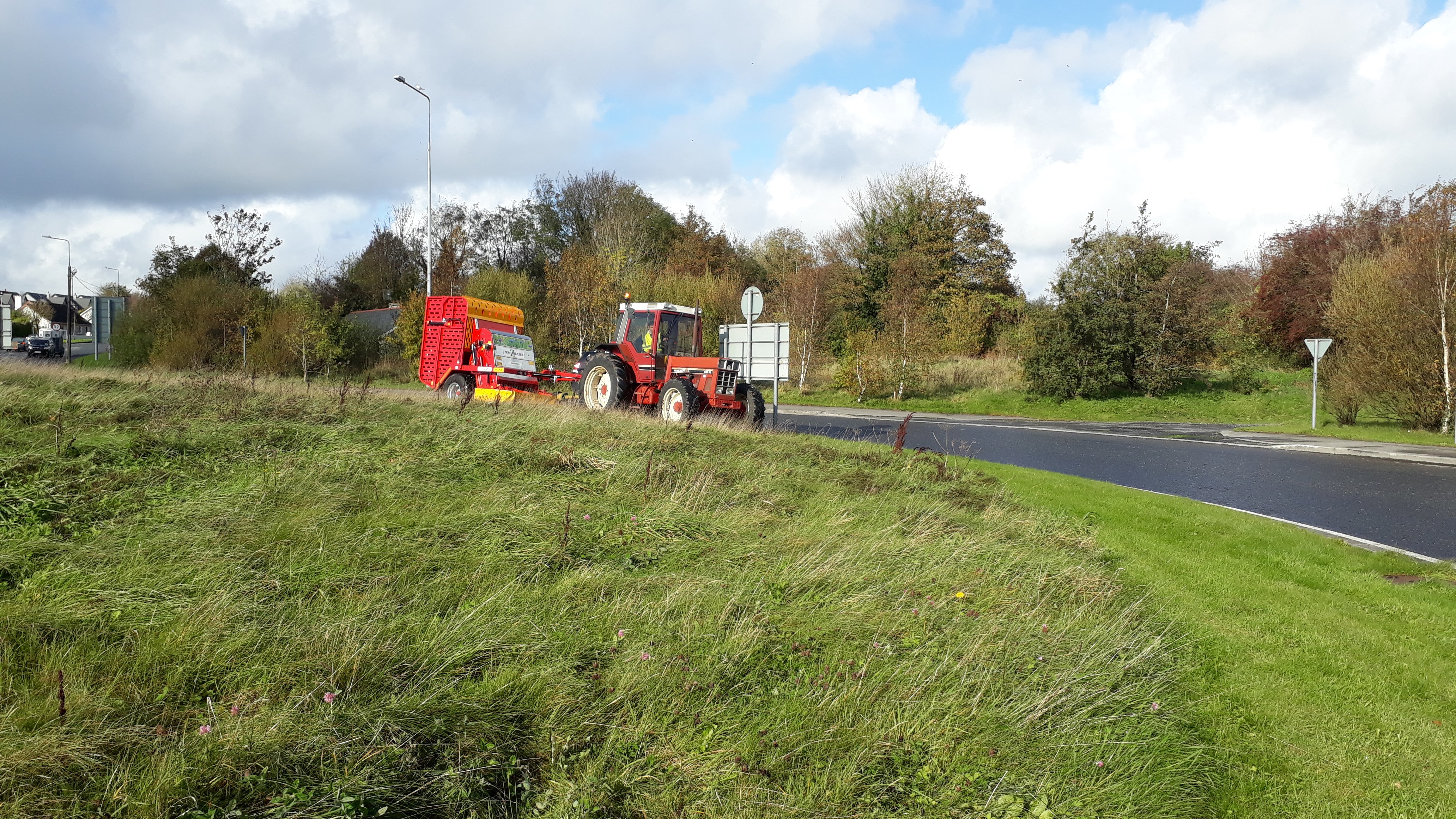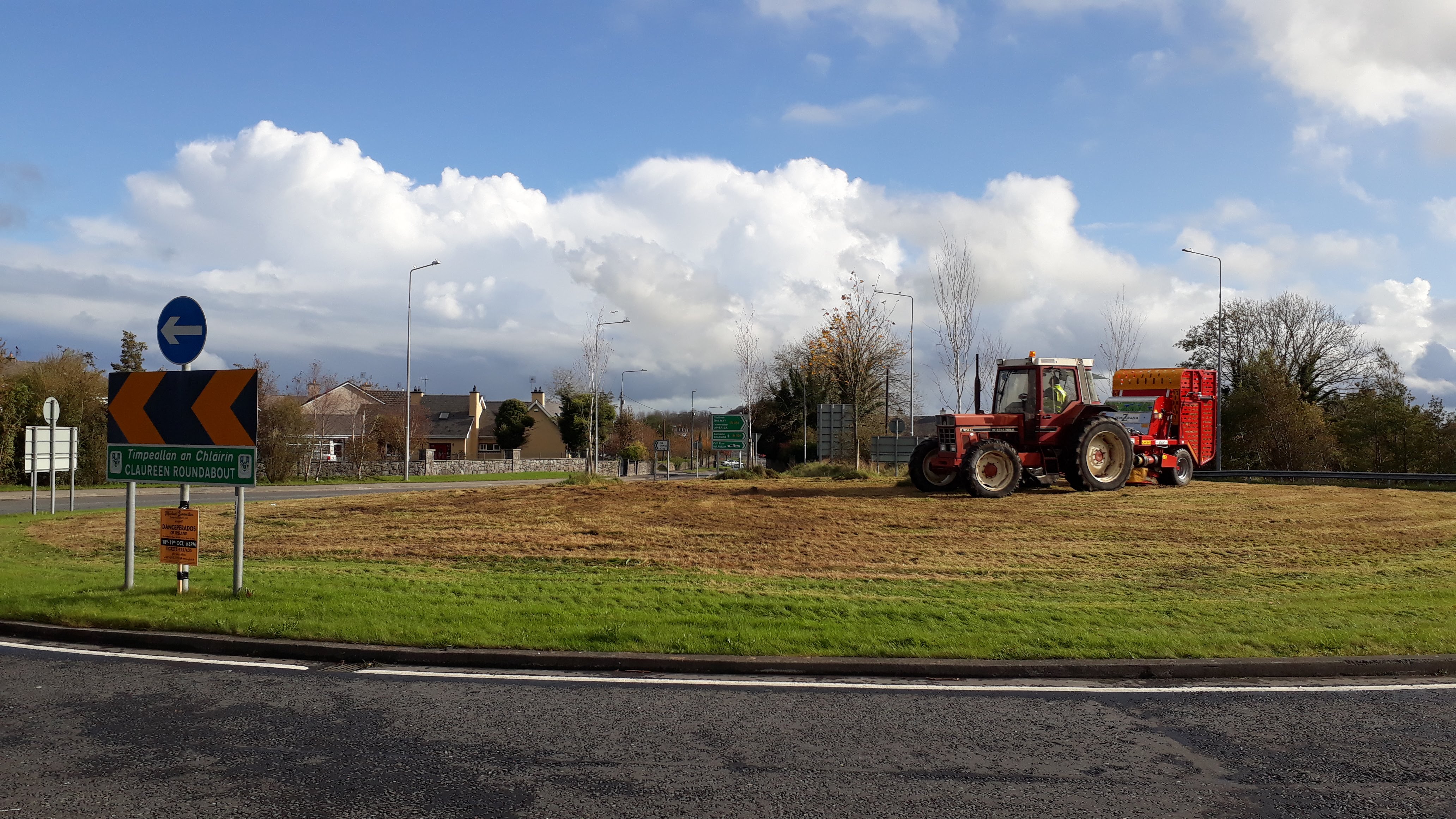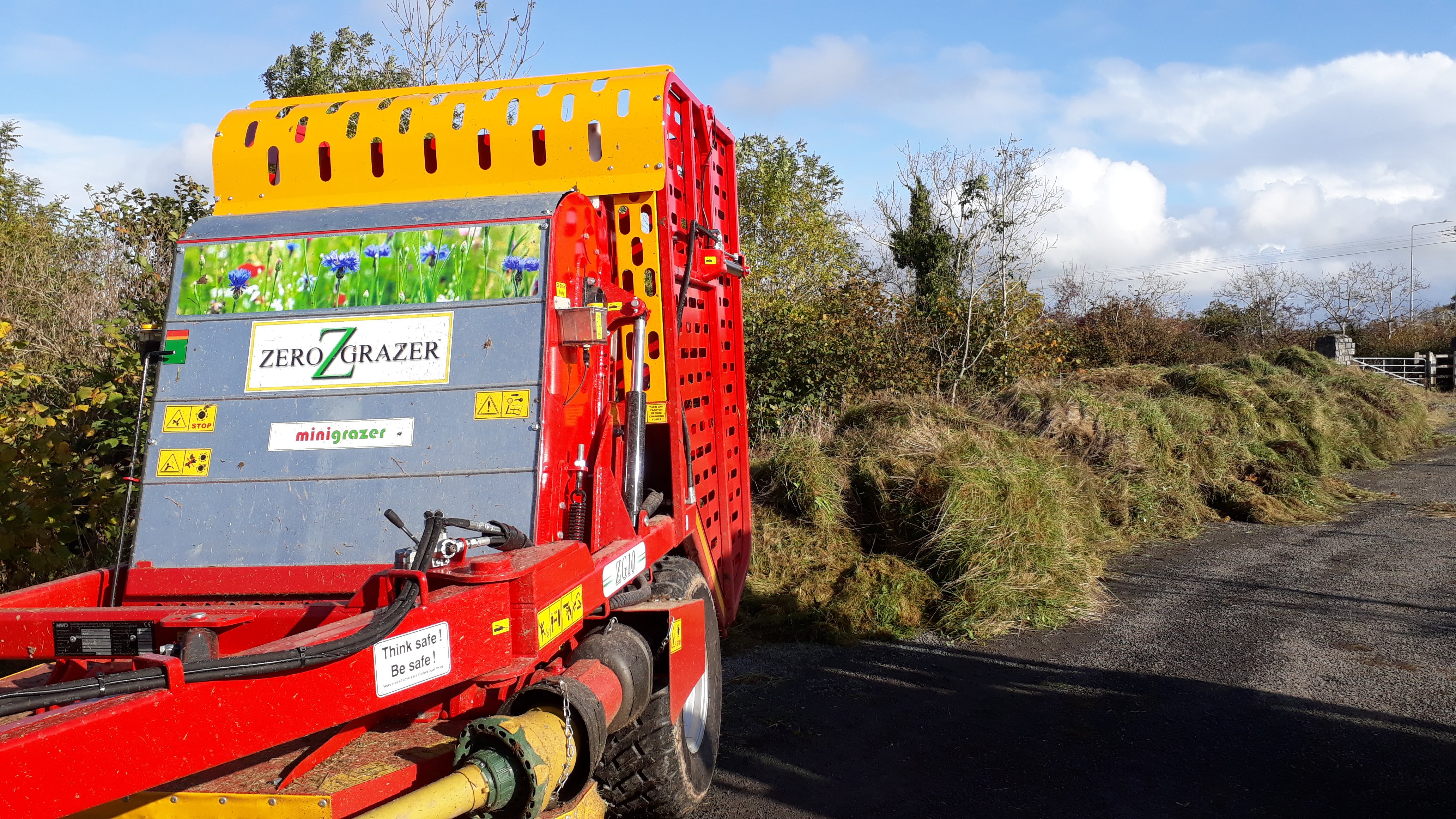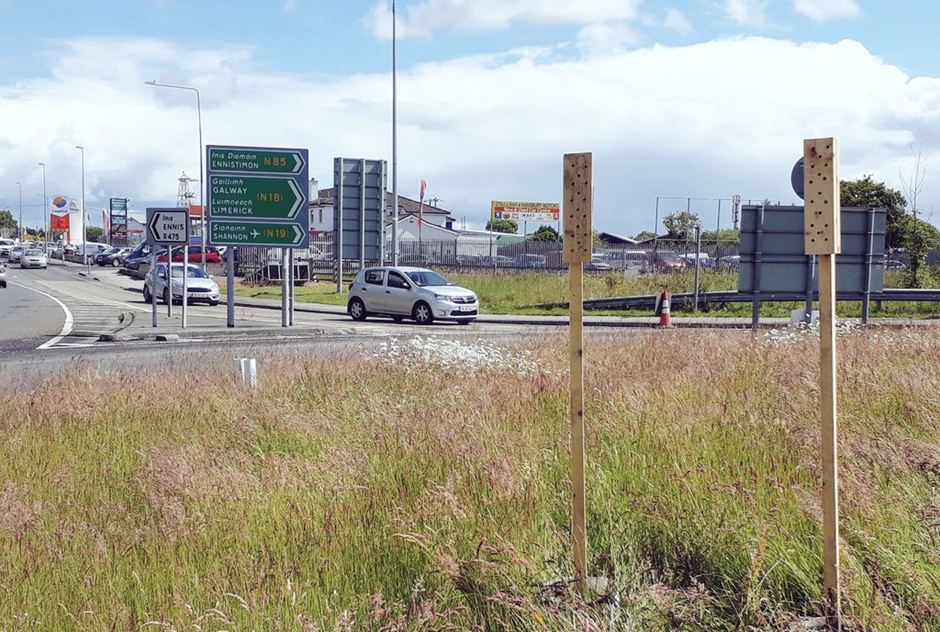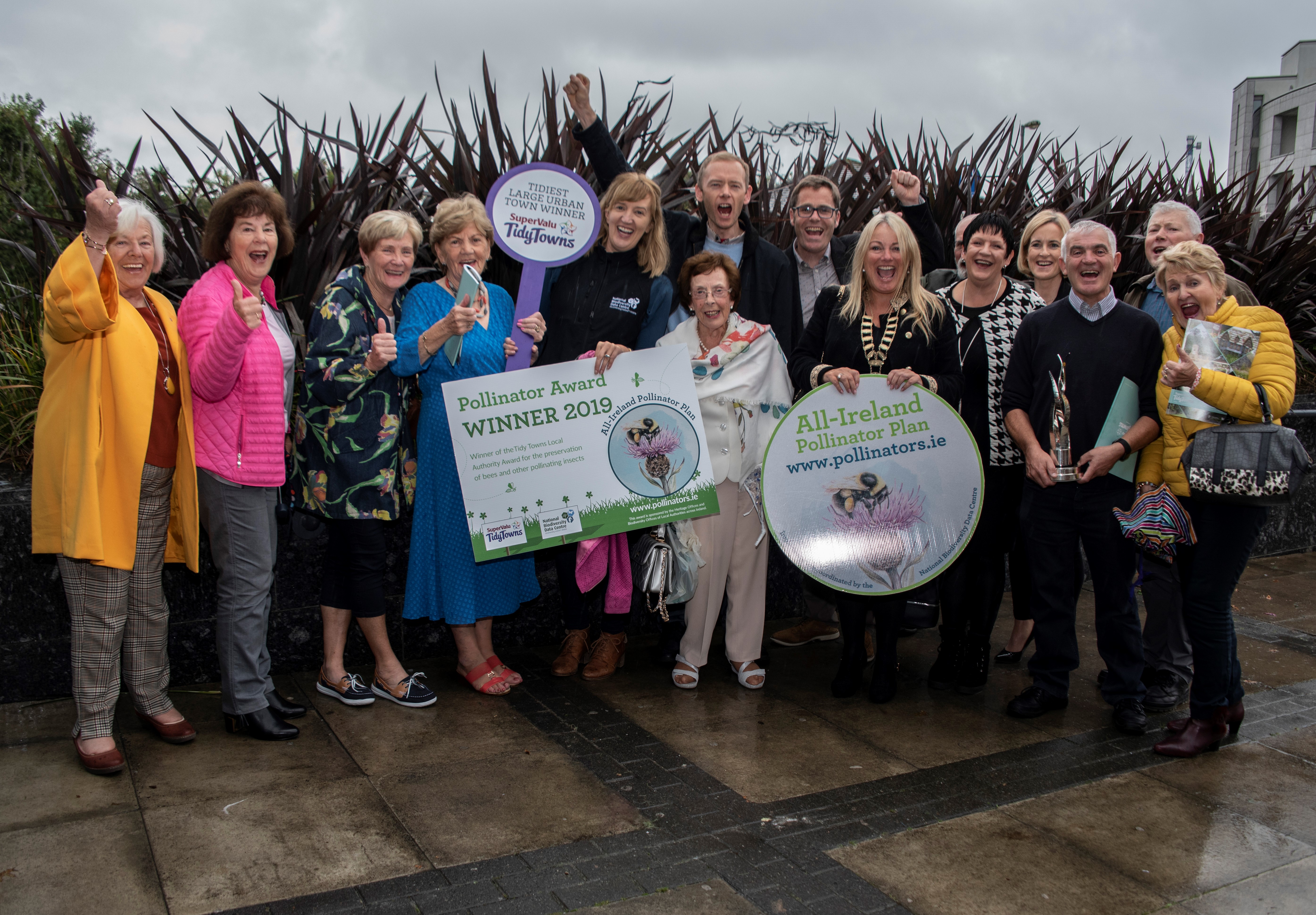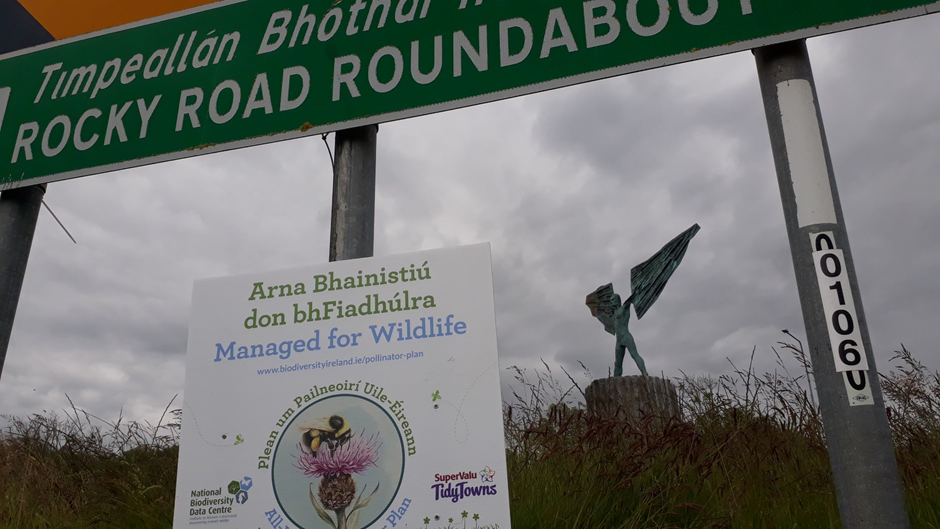Chairman of Ennis Tidy Towns Group, Cormac McCarthy explains how they
let the native seedbank do the work, with cut-and-lift management,
to produce wonderful wildflower displays on the town’s roundabouts.
Beechpark Roundabout
Currently in Ennis, 80% of our grassed roundabouts are subject to pollinator-friendly management, as championed by Ennis Tidy Towns with assistance from Ennis Municipal District Staff. The decision was made to manage these areas for pollinators and wildlife in general, without supplementary planting*.
To ensure public support for the roundabouts, we did ask for the edges of the roundabouts to be cut three times the mower-width and to be maintained on a regular basis. The rationale behind this was to create the perception that a purposeful form of management was taking place and that the roundabouts had not simply ‘been forgotten about’. Claureen Roundabout was also augmented with art pieces of bees and butterflies, made from upcycled paint cans, along with All-Ireland Pollinator Plan signage. We regularly post photos of the sites on social media to reinforce the need for this change in management.
The mown edge on Cappahard Roundabout helps to create a managed appearance
Claureen Roundabout, on road from Lahinch/Cliffs of Moher – with mown edge and sculptures
Each year we meet with Council staff and the contractor charged with maintaining the areas for that season. Often this involves site visits to reinforce the type of management we need.
This form of pollinator-friendly management commenced in 2017 and we could instantly see a change in floral diversity. For example, at Claureen roundabout, we noticed orchids, clovers, knapeed, etc. flourishing. At Beechpark Roundabout, there was a peculiar vista of approx. 50% of the roundabout awash with Ox-eye daisy and the other half almost exclusively grass. This may have been due to different soil types being imported at the time of its creation. It is hoped, over time, that the change in management will increase the floral diversity here.
The roundabouts were left to grow from early Spring to the end of September/early October in line with recommendations from the Pollinator Plan. In 2018, we continued this management and once again noticed increasing diversity. In 2019, the number of roundabouts were expanded to two additional sites. All sites have been added to the Pollinator Plan ‘Actions for Pollinators mapping system – https://pollinators.biodiversityireland.ie/.
In 2019, we wanted to obtain the relevant scientific evidence from these sites in order to promote this form of management. A local botanist, Donncha O’Cathain, volunteered to assess the roundabouts and compare species diversity with a nearby, manicured roundabout – Clareabbey Roundabout. This comprehensive botanical audit yielded the following results:
|
Site |
Mowing Regimen |
Number of Species Recorded |
Percentage Difference of Species Count Relative to Regularly Mowed Site (Clareabbey) |
|
Clareabbey |
Regular Mowing |
17 |
NA |
|
Claureen |
Once Annually |
24 |
+29% |
|
Beechpark |
Once Annually |
35 |
+51% |
As you can see, just by changing the management, the diversity at grassed roundabouts increases substantially. It also acts as a focus for discussion and awareness raising. Using this sound scientific basis, which proves the change in management has tangible benefits, we plan on approaching other stakeholders to investigate expanding this initiative.
It should be noted that there can be hiccups in management due to crossed wires or miscommunication. For example, Claureen Roundabout received two full cuts in early Summer – we believe this is what accounts for the lower increase compared to Beechpark.
We worked closely with the Council and contractor to rectify this, with the result that through the remainder of the summer, our sites received the exact management requested. Mistakes do happen. We recommend learning from them and working with your project partners to ensure mistakes do not reoccur. But sustaining those relationships should also be key. Wildflowers will grow back, partnerships may not mend as quickly!
“Mistakes do happen.
We recommend learning from them and working with your project partners to ensure mistakes do not re-occur.
But sustaining those relationships should also be key.
Wildflowers will grow back, partnerships may not mend as quickly!”
Cut & Collection Phase
For many communities, the main obstacle to adopting pollinator-friendly grass management is the annual ‘cut and collect’ action. Cutting is simple; it is the follow-up collection exercise that can be very labour intensive and/or pose certain logistical issues. This is very much the case when managing roundabouts for biodiversity, given their location on often busy roads.
Firstly we made the decision to leave the roundabouts grow until early to mid-October, not mid- to end-September as outlined in the Pollinator Plan guidelines. This had the two-fold benefit of providing a source of food well into the Autumn for pollinators as well as letting flowers naturally drop their seeds. This then removed the need to leave the cuttings lie for a few days so they would drop their seeds and then collect. We could now try and cut and collect at the same time, hopefully saving time and resources.
We had a number of options open to us in Ennis:
- Cut the grass and leave in situ: This is the least preferred option as the decomposing grass will lead to a rise in nutrients which would lead to reduced floral diversity in subsequent years (as grasses do better in nutrient-rich soils at the expense of wildflowers).
- Cut the grass and then collect using hired agricultural plant: Though our roundabouts are large by normal standards they are still not sufficiently large to allow for access by heavy duty farm machinery. The resultant rutting and impact to the grassed surface would also be unsightly and potentially have negative impacts on the grassland habitat by overly compacting the underlying soil.
- Cut and rake by hand: This would only be feasible on one of our roundabouts as the others are far too large. This would have required significant voluntary hours and given the location on busy roads, possible health and safety implications. Also, what to do with the cuttings? Some of our roundabouts have ragwort which could be detrimental to livestock.
We then heard about a ‘Zero Grazer’ – a piece of plant commonly used by dairy farmers to cut and collect grass as feed. However, upon looking at the company’s website and approaching several plant hire companies we soon learned that the size of these machines was much too large for our needs. We contacted the firm directly and learned about the ZB10 – a new, small scale Zero Grazer which was only launched at the 2019 Ploughing Championships.
While the Zero Grazer company did not lease machinery, after discussing our needs, the owner, Niall O’Reilly agreed to run a pilot exercise so the efficacy of the machine could be tested. This would be the first use of the machine in Ireland. Our roundabouts – varying from small to large – posed the ideal test environment. The timing was perfect, with no small amount of luck, too!
The four roundabouts each had upwards of six months’ growth – varying in sward height and vegetation density.
Zero Grazer, the ZB10, beginning to cut at Claureen Roundabout
The Zero Grazer – a single axle unit – was pulled by a 1,000 horsepower tractor, though in reality a 700 horsepower tractor is more than sufficient. The Zero Grazer left minimal tracks on the roundabouts and the use of a smaller tractor would reduce this even more. Regardless, we are confident that in a number of weeks this minimal visual impact will have completely abated. Each load contained upwards of 1 tonne of cut vegetation.
The exercise resulted in:
- The roundabouts, including offloading cuts, took 3 hours. The roundabouts had been subject to the 7 cuts per season prior to 2017. We calculated that this resulted in a time saving of approx. 15 hours as the original practice was to cut and mulch however there was no time lost on offloading cut material.
- The saved 15 hours equates to 15 hours of diesel emissions not being released into the atmosphere.
- The discontinuation of mulching means that, in time, the soil nutrient level will decrease.
- 8 tonnes of grass was removed from the 4 roundabouts. This material was stockpiled until the end of the day and then transported to the Central Waste Management Composting Facility in Inagh, Co. Clare. We are indebted to Clare County Council for accepting this material free of charge as well as covering the transport costs. Alternative options discussed were designation of a sacrificial site of lower ecological value to allow the material self-compost or transport each load as it was cut to a waiting lorry. The adopted measure was the most cost and time effective.
- Roads did not have to be closed though strict controls in terms of directing traffic was necessary to ensure safe access and egress off the roundabouts by the contractor.
“The saved 15 hours equates to 15 hours of diesel emissions not being released into the atmosphere.”
Job done!
Temporary site prior to transfer to Central Waste Management Facility composting site in Inagh, Co. Clare
Where to from here?
We have identified this Zero Grazer as the most appropriate and sustainable way forward. We appreciate that this would represent a capital investment of approximately €25,000 to a Council or community group but we feel there are a number of ways to ensure value for money. These include:
- A cost-benefit analysis should be undertaken which looks at time, staff and resource savings over a 5 to 10-year period.
- This type of management is the way forward in terms of biodiversity management and is complementary to a number of actions in both a Council’s County Development Plan as well as Heritage and Biodiversity Plan.
- Having varying sward heights is both good for addressing the Biodiversity crisis as well as the Climate Crisis as grasslands act as carbon sinks – two key areas for action by central and local Government.
- A single unit could be used to manage a variety of sites throughout the county as well as expanding the management currently being piloted in Ennis.
- The piece of plant could be rented to private sports grounds or other facilities, thereby developing a revenue stream for the unit.
- The plant could be leased to or undertake work for other State Agencies who have signed up to the All-Ireland Pollinator Plan under Service Level Agreements.
Solitary Bee hotels made by local Ennis Chamber CE Scheme at the Kilrush Road Roundabout
Ennis Tidy Towns, winners of a regional Local Authority Pollinator Award in 2018 and 2019. Ennis also won the Tidy Towns award for Tidiest Large Urban Town, showing that you can help biodiversity and still maintain marks for neatness.
Pollinator Plan Signage at Rocky Road Roundabout
|
[*NOTE from Editor: Wildflowers grow better in less fertile soil. Grasses do better in nutrient-rich soil. By removing clippings rather than mulching, you prevent nutrients returning to the soil, and thereby help the wildflowers to gain a foothold in the following season. It may take a number of years before your meadow becomes less grassy and more flower-rich. It will gradually improve year upon year if the grass cut is lifted. In the early years, pernicious weeds (e.g. Ragwort) should be pulled. A number of resources are available on the Pollinator Plan website, including: How-to-guide on collecting and using local pollinator friendly wildflower seed to naturally improve meadows. This is something that local community groups or schools could get involved in.] |

